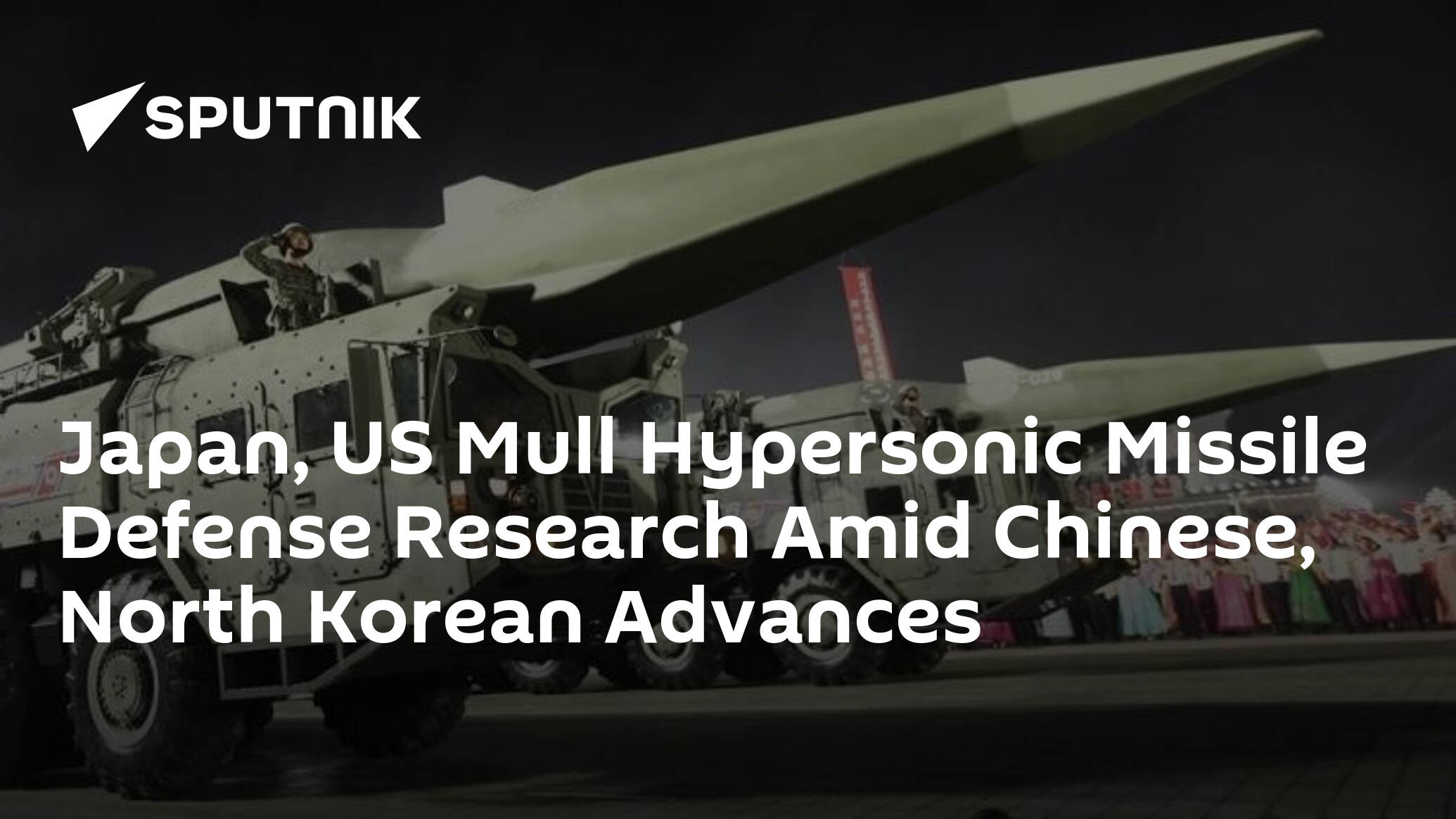https://sputniknews.com/20221204/japan-us-mull-hypersonic-missile-defense-research-amid-chinese-north-korean-advances-1105035483.html
Japan, US Mull Hypersonic Missile Defense Research Amid Chinese, North Korean Advances
Japan, US Mull Hypersonic Missile Defense Research Amid Chinese, North Korean Advances
China became the second country in the world to field a hypersonic weapons system with its DF-ZF hypersonic glide vehicle, introduced in 2019. In 2021 and… 04.12.2022, Sputnik International
2022-12-04T17:54+0000
2022-12-04T17:54+0000
2022-12-04T18:28+0000
military
hypersonic
hypersonic missiles
hypersonic weapons
china
japan
north korea
intercept
missile interceptor
interceptor
/html/head/meta[@name=’og:title’]/@content
/html/head/meta[@name=’og:description’]/@content
https://cdnn1.img.sputniknews.com/img/07e6/0c/04/1105035333_3:0:750:420_1920x0_80_0_0_ce7a4dc98f2049f3471515274da06b50.jpg
Japan and the United States are mulling teaming up for joint research into technologies related to the interception of hypersonic glide weapons.Japan’s Defense Ministry reportedly plans to start work on an anti-missile interceptor capable of operating at altitudes that the current generation of anti-missile defenses cannot reach in 2023.What Tokyo needs from Washington is assistance on technologies which would allow rockets to change trajectory in flight, enabling them to hone in on maneuvering hypersonic targets during their ultra-high-speed approach.If cooperation proves fruitful, the interceptor missiles are expected to be deployed on board Japan’s Aegis air and missile defense system-equipped destroyers, set to be commissioned in 2027 and 2028, respectively.Japanese plans to ramp up cooperation with the US on counter-hypersonic weapons research were first reported on earlier this year, with Secretary of State Antony Blinken confirming in January that an agreement had been penned on R&D in emergent technologies, including AI, directed energy weapons, quantum computing, space weaponry, and countering hypersonic missiles. No further details were provided at the time. Japanese Defense Minister Yasukazu Hamada and Pentagon chief Lloyd Austin reportedly discussed the issue during a meeting in September.The utility of teaming up with US engineers on hypersonic defense research is questionable, given that US missile defense systems have occasionally failed to detect even conventional ballistic missile launches by North Korea. US made Patriots, Aegis, and Terminal High Altitude Area Defense (THAAD) systems did not shoot down a North Korean ballistic missile as it flew over the northern Japanese island of Hokkaido in 2017, prompting questions from the media as to why.At the same time, the US has yet to field any of the half-a-dozen hypersonic weapons systems it has under development, with the US Army only expecting to take delivery of its first Long-Range Hypersonic Weapon (LRHW), a ground-launched, boost-glide missile system, next year.The news on Japanese-US cooperation comes after reports last month that Tokyo was planning to tinker with its existing Type-03 intermediate-range guided missile air defense systems to intercept hypersonic weapons. The missile systems, developed in the 1990s and introduced into service in 2003, have an effective range of 50 km, a speed of Mach 2.5, and a high-explosive warhead activated via proximity fuse.Japan’s coalition government agreed Friday that the country needs to create a homegrown “counterstrike capability” amid the deteriorating security situation in the region, with plans calling for the deployment of new weapons that can destroy enemy missiles before they are launched. The strategy refrained from including “command and control” centers in its list of potential targets after a declaration in North Korea’s official nuclear strategy document in September that Pyongyang would consider nuclear retaliation in response to enemy attempts to carry out a decapitation strike targeting the DPRK’s leaders.Last month, Japan’s Defense Ministry outlined steps to develop its own hypersonic missiles by 2030, with the announcement coming after the successful testing of an experimental scramjet air-breathing engine in July. Japan began work on two indigenous hypersonic weapons concepts – the Hypersonic Cruise Missile (HCM) and the Hyper Velocity Gliding Projectile (HVGP), in 2020.Japan’s current government has broken with decades of modest defense spending increases by the island nation, with Tokyo planning to more than double spending to about $125 billion US, from about $49 billion now, over the next five years, it’s largest increase in spending since the Second World War.News of the joint Japanese-US research into hypersonic defenses comes amid the growing technological prowess of Japan’s potential regional adversaries.China declared its DF-ZF hypersonic glide vehicle operational in 2019. The vehicle is capable of accelerating to speeds of up to Mach 10 (12,360 km per hour), and carrying out both nuclear or conventional strikes against layered air defenses. The DF-ZF can be fitted on board a range of existing Chinese missiles, including the DF-21 medium-range missile and the DF-31 intercontinental ballistic missile (the latter has a range of up to 8,000 km).The development also comes amid longstanding tensions on the Korean Peninsula. Last year, North Korea unveiled and tested the Hwasong-8 – a hypersonic glide vehicle with features similar to the DF-ZF mounted aboard a Hwasong-14 ICBM. Japan’s military confirmed the missile’s test launches in September 2021 and January 2022, but characterized the weapon as a “new type” of ballistic missile, rather than a hypersonic weapon.
https://sputniknews.com/20221128/japan-mulls-equipping-submarines-with-long-range-missiles-reports-say-1104783146.html
https://sputniknews.com/20220909/dprks-new-nuclear-doctrine-is-cheapest-fastest-way-to-get-deterrent-us-will-take-seriously-prof-1100602477.html
https://sputniknews.com/20221128/japan-to-launch-50-military-satellites-starting-fiscal-year-2024-reports-say-1104772056.html
china
Sputnik International
feedback@sputniknews.com
+74956456601
MIA „Rosiya Segodnya“
2022
News
en_EN
Sputnik International
feedback@sputniknews.com
+74956456601
MIA „Rosiya Segodnya“
Sputnik International
feedback@sputniknews.com
+74956456601
MIA „Rosiya Segodnya“
hypersonic, anti-hypersonic, missile, interceptor missile, anti-missile missile, north korea, japan, china, research, us, joint research
hypersonic, anti-hypersonic, missile, interceptor missile, anti-missile missile, north korea, japan, china, research, us, joint research
17:54 GMT 04.12.2022 (Updated: 18:28 GMT 04.12.2022)
China became the second country in the world to field a hypersonic weapons system with its DF-ZF hypersonic glide vehicle, introduced in 2019. In 2021 and early 2022, the Democratic People’s Republic of Korea showed off its own prowess in this area.
Japan and the United States are mulling teaming up for joint research into technologies related to the interception of hypersonic glide weapons.
Japan’s Defense Ministry reportedly plans to start work on an anti-missile interceptor capable of operating at altitudes that the current generation of anti-missile defenses cannot reach in 2023.
What Tokyo needs from Washington is assistance on technologies which would allow rockets to change trajectory in flight, enabling them to hone in on maneuvering hypersonic targets during their ultra-high-speed approach.
If cooperation proves fruitful, the interceptor missiles are expected to be deployed on board Japan’s Aegis air and missile defense system-equipped destroyers, set to be commissioned in 2027 and 2028, respectively.
Japanese plans to ramp up cooperation with the US on counter-hypersonic weapons research were first reported on earlier this year, with Secretary of State Antony Blinken confirming in January that an agreement had been penned on R&D in emergent technologies, including AI, directed energy weapons, quantum computing, space weaponry, and countering hypersonic missiles. No further details were provided at the time. Japanese Defense Minister Yasukazu Hamada and Pentagon chief Lloyd Austin reportedly discussed the issue during a meeting in September.
The utility of teaming up with US engineers on hypersonic defense research is questionable, given that US missile defense systems have occasionally failed to detect even conventional ballistic missile launches by North Korea. US made Patriots, Aegis, and Terminal High Altitude Area Defense (THAAD) systems did not shoot down a North Korean ballistic missile as it flew over the northern Japanese island of Hokkaido in 2017, prompting questions from the media as to why.
At the same time, the US has yet to field any of the half-a-dozen hypersonic weapons systems it has under development, with the US Army only expecting to take delivery of its first Long-Range Hypersonic Weapon (LRHW), a ground-launched, boost-glide missile system, next year.
The news on Japanese-US cooperation comes after reports last month that Tokyo was planning to tinker with its existing Type-03 intermediate-range guided missile air defense systems to intercept hypersonic weapons. The missile systems, developed in the 1990s and introduced into service in 2003, have an effective range of 50 km, a speed of Mach 2.5, and a high-explosive warhead activated via proximity fuse.
Japan’s coalition government agreed Friday that the country needs to create a homegrown “counterstrike capability” amid the deteriorating security situation in the region, with plans calling for the deployment of new weapons that can destroy enemy missiles before they are launched. The strategy refrained from including “command and control” centers in its list of potential targets after a declaration in North Korea’s official nuclear strategy document in September that Pyongyang would consider nuclear retaliation in response to enemy attempts to carry out a decapitation strike targeting the DPRK’s leaders.
Last month, Japan’s Defense Ministry outlined steps to develop its own hypersonic missiles by 2030, with the announcement coming after the successful testing of an experimental scramjet air-breathing engine in July. Japan began work on two indigenous hypersonic weapons concepts – the Hypersonic Cruise Missile (HCM) and the Hyper Velocity Gliding Projectile (HVGP), in 2020.
Japan’s current government has broken with decades of modest defense spending increases by the island nation, with Tokyo planning to more than double spending to about $125 billion US, from about $49 billion now, over the next five years, it’s largest increase in spending since the Second World War.
News of the joint Japanese-US research into hypersonic defenses comes amid the growing technological prowess of Japan’s potential regional adversaries.
China declared its DF-ZF hypersonic glide vehicle operational in 2019. The vehicle is capable of accelerating to speeds of up to Mach 10 (12,360 km per hour), and carrying out both nuclear or conventional strikes against layered air defenses. The DF-ZF can be fitted on board a range of existing Chinese missiles, including the DF-21 medium-range missile and the DF-31 intercontinental ballistic missile (the latter has a range of up to 8,000 km).
The development also comes amid longstanding tensions on the Korean Peninsula. Last year, North Korea unveiled and tested the Hwasong-8 – a hypersonic glide vehicle with features similar to the DF-ZF mounted aboard a Hwasong-14 ICBM. Japan’s military confirmed the missile’s test launches in September 2021 and January 2022, but characterized the weapon as a “new type” of ballistic missile, rather than a hypersonic weapon.




